The ratio of coffee to water the standard brewing ratio of hand-brewed coffee
Standard brewing ratio (Standard Brewing Ratio)
Number of cups of coffee
Cups of
Coffee
The amount of coffee used COFFEE TO BE USED
Water consumption WATER TO BE USED
By weight
BY WEIGHT
Meter by measuring tool
BY MEASURE
Ounce Ounces
Gram Grams
Teaspoon Tea
Spoons
Spoon Table
Spoons
Cup Cups
Coffee liquid (oz)
Fluid
Ounces
Number of cups Cups
Pint Pints
Quart Quarts
One GAL, two gallons, two gallons.
Ml CCs
(milliliters)
L Liters
1
0.38
10.6
6
2
1/8
8
1
1/2
1/4
1/8
237
0.24
2
0.75
21.3
12
4
1/4
16
2
1
1/2
1/4
473
0.47
3
1.13
31.9
18
6
3/8
24
3
1 1/2
3/4
3/8
710
0.71
4
1.50
42.5
24
8
1/2
32
4
2
1
1/2
947
0.95
5
1.88
53.2
30
10
5/8
40
5
2 1/2
1 1/4
5/8
1183
1.18
6
2.25
63.8
36
12
3/4
48
6
3
1 1/2
3/4
1420
1.42
7
2.63
74.4
42
14
7/8
56
7
3 1/2
1 3/4
7/8
1656
1.66
8
3.00
85.1
48
16
1
64
8
4
2
1
1893
1.89
9
3.38
95.7
54
18
1 1/8
72
9
4 1/2
2 1/4
1 1/8
2130
2.13
10
3.75
106.3
60
20
1 1/4
80
10
5
2 1/2
1 1/4
2366
2.37
11
4.13
116.9
66
22
1 3/8
88
11
5 1/2
2 3/4
1 3/8
2603
2.60
12
4.50
127.6
72
24
1 1/2
96
12
6
3
1 1/2
2840
2.84
If you know the amount of coffee powder, multiplied by the coefficient 21.33, you know how many ounces of water you need (0.046875 is the inverse coefficient), multiplied by the coefficient 22.2593, you get how many milliliters of water you need (0.04493 is the inverse coefficient).
For example, if you have 1.2oz coffee powder, multiply it by 21.33g, you will need 25.6oz water; 92.6g coffee powder will need 2061CCs water. The amount of coffee powder required can be obtained by multiplying the inverse coefficient with the known amount of water.
The brewing ratio of enthusiasts Connoisseur's Brewing Ratio
Cups of
Coffee
The amount of coffee used COFFEE TO BE USED
Water consumption WATER TO BE USED
BY WEIGHT
BY MEASURE
Ounces
Grams
Tea
Spoons
Table
Spoons
Cups
Fluid
Ounces
Cups
Pints
Quarts
1/2 Gal
CCs
(milliliters)
Liters
1
0.38
10.6
6
2
1/8
6
3/4
3/8
3/16
3/32
177
0.18
2
0.75
21.3
12
4
1/4
12
1 1/2
3/4
3/8
3/16
355
0.35
3
1.13
31.9
18
6
3/8
18
2 1/4
1 1/8
9/16
9/32
532
0.53
4
1.50
42.5
24
8
1/2
24
3
1 1/2
3/4
3/8
710
0.71
5
1.88
53.2
30
10
5/8
30
3 3/4
1 7/8
15/16
15/32
887
0.89
6
2.25
63.8
36
12
3/4
36
4 1/2
2 1/4
1 1/8
9/16
1065
1.06
7
2.63
74.4
42
14
7/8
42
5 1/4
2 5/8
1 5/16
21/32
1242
1.24
8
3.00
85.1
48
16
1
48
6
3
1 1/2
3/4
1420
1.42
9
3.38
95.7
54
18
1 1/8
54
6 3/4
3 3/8
1 11/16
27/32
1597
1.60
10
3.75
106.3
60
20
1 1/4
60
7 1/2
3 3/4
1 7/8
15/16
1775
1.77
11
4.13
116.9
66
22
1 3/8
66
8 1/4
4 1/8
2 1/16
1 1/32
1952
1.95
12
4.50
127.6
72
24
1 1/2
seventy-two
nine
4 1/2
2 1/4
1 1/8
2130
2.13
If you know the amount of coffee powder, times the coefficient 16, you know how many ounces of water you need (0.0625 is the inverse coefficient), multiplied by the coefficient 16.6945, you get how many milliliters of water you need (0.04493 is the inverse coefficient).
For example, if you have 1.2oz coffee powder multiplied by 16.0, you need 19.2oz water; 92.6g coffee powder requires 1562CCs (1.56L) water. The amount of coffee powder required can be obtained by multiplying the inverse coefficient with the known amount of water.
Comparing the two tables, it is not difficult to find that the so-called brewing of enthusiasts is just a little higher in concentration and heavier in taste.
To put it simply, under normal circumstances, one serving of powder (10 grams) is washed into about 22 parts (220 grams) of water, while enthusiasts use one part of powder (10 grams) to flush about 160,17 parts of water (160,170g water).
The picture below is the coffee brewing rate chart of SCAA. If you have the TDS gadget and find that the value of coffee is within the yellow box in the middle of the table below, the coffee wine is relatively balanced and delicious. In this table, the Abscissa is the coffee extraction rate, that is, the ratio of the coffee ingredients extracted from the coffee beans (powder) to the coffee beans (portions). The ordinate represents the ratio of the extracted coffee ingredients (special hint: this is not the weight of the coffee powder) to the total coffee liquid, also known as concentration. The conclusion of SCAA's long-term observation and research is that when the extraction rate of coffee is 180.22% and the concentration is 1.15 ~ 1.35% (that is, the range of yellow box), the taste of coffee is the best (balanced and delicious).
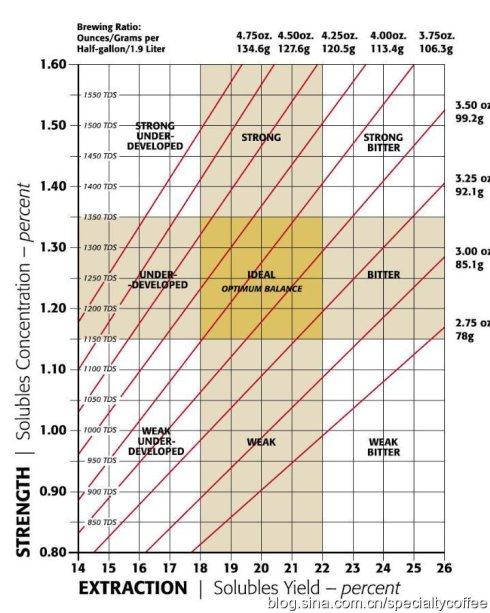
The Gold Cup Programme is a European drive by the SCAE to improve the standard of filter coffee consumed in the marketplace. It ensures a WIN for the Coffee Roaster, a WIN for the Restaurateur and a WIN for the consumer.
SCAE Gold Cup = Win-Win-Win
The SCAE’s Gold Cup programme promotes a better, measurable standard in filter coffee. This will be achieved by recognising an internationally respected set of rules on brewing filter coffee.
The Gold Cup sets minimum standards for coffee to water ratio, brewing temperature and holding time, and optimum standards for coffee extraction and strength.
How the Gold Cup works:The SCAE Gold Cup uses the industry to monitor itself, backed up by incontrovertible and well-researched scientific data to ensure the integrity of the Gold Cup as a quality standard is objectively maintained.
THE ART OF BREWING – WHAT IS THE PERFECT CUP?
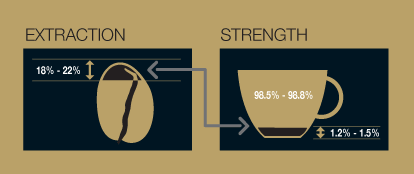
There are acres of paper filled with data on coffee, coffee origins, coffee roasting and coffee flavour profiles. All these things have huge importance on what goes in the cup.
As important is the alchemy or art of turning a coffee bean and water into a perfectly extracted cup of coffee.
The Art of Brewing is effectively taking between 18 and 22% of a coffee bean and extracting it into approx 1.3% of the finished beverage.
The most important aspect of 'the perfect cup' is the balance between strength of the beverage and correct extraction of the bean.
THE SCIENCE OF BREWING-HOW TO GET THE PERFECT CUP
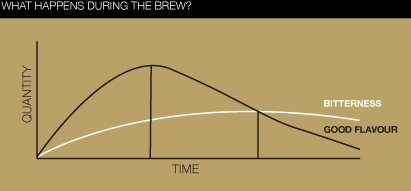
Filter coffee as defined by the SCAE Gold Cup standard-
'A ratio of 1 litre of fresh water brewed at 92 °to 96 °C through 50 to 65g of freshly ground coffee and filtered through an oxygen-bleached filter paper to extract between 18% and 22% of solids from the coffee.'
Scientifically, there are many aspects which influence the quality of filter coffee, most significantly:
1. Grammage-How much coffee we use per litre of water.
2. Grind-How coarse or fine we grind the roasted coffee bean
3. Contact Time-How long the ground beans and water are in contact to extract the brew.
4. Temperature-How consistent and what temperature the water is at brew time.
Compiled by Huang Wei
Important Notice :
前街咖啡 FrontStreet Coffee has moved to new addredd:
FrontStreet Coffee Address: 315,Donghua East Road,GuangZhou
Tel:020 38364473
- Prev
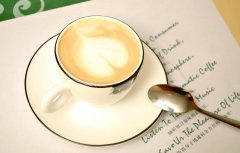
Eight principles for judging Coffee by Cup timing techniques for Coffee Taste
The first principle: [clean], clean when light, and clean when strong. It's like a room, it's easy to be clean when it's empty, but it has to be clean when it's full. The second principle: [spindle flavor], that is, it represents the characteristics of this region. Cleanliness is the foundation, and an unclean cup of coffee represents a flaw, but clean coffee can easily become tasteless.
- Next
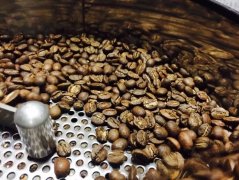
How do you brew Italian coffee beans? What kind of equipment should I use?
What are Italian coffee beans? In a nutshell, it's Italian coffee beans. Use two or more kinds of individual coffee beans to form a kind of coffee beans, also known as Italian coffee beans. Second, the reasons for the blending of Italian coffee beans? Although some fixed varieties of coffee can be drunk directly as individual coffee, most of the coffee exists or more in flavor.
Related
- Detailed explanation of Jadeite planting Land in Panamanian Jadeite Manor introduction to the grading system of Jadeite competitive bidding, Red bid, Green bid and Rose Summer
- Story of Coffee planting in Brenka region of Costa Rica Stonehenge Manor anaerobic heavy honey treatment of flavor mouth
- What's on the barrel of Blue Mountain Coffee beans?
- Can American coffee also pull flowers? How to use hot American style to pull out a good-looking pattern?
- Can you make a cold extract with coffee beans? What is the right proportion for cold-extracted coffee formula?
- Indonesian PWN Gold Mandrine Coffee Origin Features Flavor How to Chong? Mandolin coffee is American.
- A brief introduction to the flavor characteristics of Brazilian yellow bourbon coffee beans
- What is the effect of different water quality on the flavor of cold-extracted coffee? What kind of water is best for brewing coffee?
- Why do you think of Rose Summer whenever you mention Panamanian coffee?
- Introduction to the characteristics of authentic blue mountain coffee bean producing areas? What is the CIB Coffee Authority in Jamaica?

